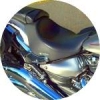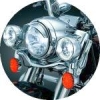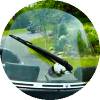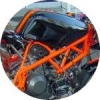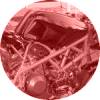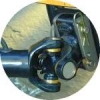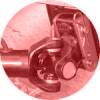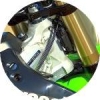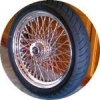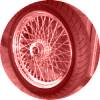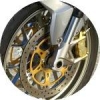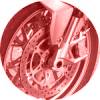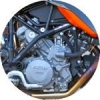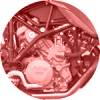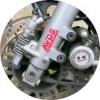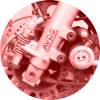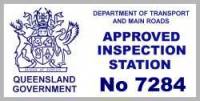Queensland Department of Transport and Main Roads introduced the safety certificate in November 1999 to replace the old roadworthy certificate or RWC, and it became
mandatory to obtain and display a current safety certificate on any registered motorcycle from the moment it's offered for sale.
The only times it's not required to display current safety certificate on a motorcycle for sale is when the motorcycle's either unregistered or is traded to or
between licensed motor dealers.
Queensland Department of Transport and Main Roads safety certificates can only be issued by Approved Inspection Stations (AIS), being service stations, garages or
workshops approved by Queensland Department of Transport and Main Roads to conduct inspections.
For private motorcycle sellers, Queensland Department of Transport and Main Roads safety certificates must be issued in the two months or 2000 kilometres prior to
sale, whichever comes first.
You are required to display a safety certificate in a conspicuous place and for motorcycles it's either on the forks or front guard.
Failure to display a Queensland Department of Transport and Main Roads safety certificate on the motorcycle from the time it's first offered for sale can carry an
on-the-spot fine penalty of $550.
Information on this website relating to motorcycle inspection is drawn from the Queensland Department of Transport and Main Roads Code of Practice for Approved
Inspection Stations (AIS) and Approved Persons; guidelines followed during safety certificate inspections and vehicle modification certification.
Following the code of practice guidelines below and rectifying faults you uncover should assure your motorcycle will pass on first inspection, avoiding any inconvenient
and possible costly re-inspection.
Vehicle inspection is subjective and the guidelines open to varying interpretation from inspector to inspector. Below is a list of reasons for possible rejection
pertaining to the Wheels and Tyres for the issuing of a Queensland Department of Transport and Main Roads safety certificate (formerly roadworthy certificate or
RWC).
SECTION 7 - WHEELS AND TYRES
Objective: To ensure that road wheels and tyres are of a suitable type and condition and they provide the necessary load carrying capacity, speed rating and control
of the vehicle.
7.1 WHEELS / RIMS
Possible reasons for inspection rejection:
- Wheels are not of an approved type and construction. (See Note 1)
- Wheels fitted to an axle or axle group are not of the same size unless otherwise specified by the vehicle manufacturer. (See Note
1)
- Wheels fitted to an axle or axle group are not of the same size unless otherwise specified by the manufacturer.
- Stud or bolt holes are expanded or elongated or wheel and retainer tapers do not match.
- Any hub has missing or broken wheel mounting nuts, studs or bolts.
- Wheels rub or foul on any part of the vehicle/trailer over its full range of travel.
- Wheels are not of an approved type and construction or are not compatible with hubs.
- Wheels fitted to an axle or axle group of a trailer are not of the same size unless otherwise specified by the vehicle
manufacturer.
- Wheels are not secure or show signs of movement, are cracked, corroded, bent, buckled, have pieces of casting missing, show signs of
welding (as a repair) or are otherwise damaged.
- A spoked wheel does not have all spokes fitted or spokes are loose, corroded, bent, broken or cracked.
- Tyre retaining rings are not in good condition or are incorrectly seated, sprung, mismatched, bent, broken, cracked, or the ends meet
when fitted to the rim.
7.2 WHEEL STUDS,NUTS, LOCKRINGS AND HUBS
Possible reasons for inspection rejection:
- Rims are not fitted with the correct number and type of nuts or studs.
- Fasteners are not securely fitted, are damaged or not engaged for at least the same thread length as provided originally by the vehicle
manufacturer.
- Any hub has missing, cracked, stripped or broken wheel mounting nuts, studs or bolts.
- Spacer plates are used between hub and wheels (except where fitted by the vehicle manufacturer).
7.3 TYRES
Possible reasons for inspection rejection:
- Tyres are not compatible with the rim to which they are fitted.
- Tyres are not of a type suitable for normal road use. (See Note 5)
- All tyres fitted to rims on the same axle are not of the same case construction (Steel radials, textile radials or conventional
crossply).
- Tyres fitted to rims on an axle or axle group are not the same size. (See Note 1)
- Tyre load ratings are less than the minimum ratings specified originally by the vehicle/trailer manufacturer.
- The speed rating of any tyre is insufficient. (See Note 2)
- Where a vehicle has been fitted with retreaded tyres, the tyres are not marked with the name or identification of the retreader of the
tyre and/or speed and load rating of the tyre.
- Tyres do not have a tread pattern at least 1.5mm deep, other than at tread wear indicators, in a band that runs continuously across the
tyre width that normally comes into contact with the road and around the whole circumference of the tyre.
- Tyre tread, shoulder or sidewall is damaged.
- Tyres have cuts, bulges, tread separation, exposed or damaged cords or other evidence of case failure.
- Any tyre on a vehicle contacts the body, inner guard, chassis, frame, braking, steering or suspension components at any point through
its full range of travel.
- Valve stems are cracked, damaged, perished or loose.
- Regrooved or recut tyres fitted to a motor vehicle are not clearly marked "suitable for Regrooving".
- Any tyre clearly marked "suitable for regrooving" is regrooved or recut beyond the maximum permissible groove depth or is regrooved or
recut in such a way that the ply or cord is exposed or damaged.
- The sidewalls of a dual tyre configuration contact each other.
7.4 TYRE / WHEEL WIDTH
Possible reasons for inspection rejection:
- For a car or car derivative, the maximum tyre width is more than 1.3 times larger than the vehicle manufacturer's widest optional tyre
width. (See Note 4)
- For an off-road passenger vehicle (four wheel drive) fitted with front and rear beam axles, the maximum tyre width is more than 1.5
times larger than the vehicle manufacturer's widest optional tyre width. (See Note 4)
- The tyre width of the narrowest tyre fitted to a vehicle is less than 70 percent of the width of the largest tyre fitted or less than
the manufacturer's narrowest optional tyre and rim as indicated on the manufacturer's tyre placard.
- The original manufacturer's front or rear wheel track for a four wheel drive/off-road passenger vehicle is increased by more than 50mm.
(See Note 3)
- The original manufacturer's front or rear wheel track measurements for a car or car derivative is increased by more than 25mm. (See
Note 3)
Notes about Section 7 (Wheels and tyres):
[1] Road wheels relate only to those wheels in contact with the road. The spare wheel is not included in a safety check.
Please also refer to the LS Section of the National Code of Practice for Light Vehicle Construction and Modification.
[2] A tyre fitted to a motor vehicle must, when first manufactured, have been rated by the tyre manufacturer as suitable for road use at the lower of:
[a] a speed of at least:
i. for an off-road passenger vehicle - 140 km/h; or
ii. for a car or car derivative - 180 km/h; or
iii. for another motor vehicle - 120 km/h; and
[b] the vehicle's top speed.
Note: Schedule 1 Section 42 of the Transport Operations (Road Use Management - Vehicle Standards and Safety) Regulation 2010 permits the use of retreaded tyres
retreaded in accordance with Australian Standard 1973. Refer to Information Sheet No. 15 in Vehicle Standards Instruction G21 - Information Sheets for Approved
Examiners.
[3] Where the manufacturer offers the option of a wider track measurement (e.g. where wider wheels are optional), the maximum allowable track will be the
maximum wheel track offered by the manufacturer plus 25mm for a car or car derivative or 50mm for a four wheel drive/off-road passenger vehicle, whichever is the
greatest.
Alternative wheels and tyre requirements for light motor vehicles are detailed in the LS Section of the National Code of Practice for Light Vehicle Construction and
Modification. Vehicle Standards Instruction G21 - Information Sheets for Approved Examiners -Information Sheet 14 has further information about vehicle
definitions.
[4] Maximum regulation dimensional limits must not be exceeded.
Note: The requirements for fitting of alternative size rims and/or tyres are covered by the LS Section of the National Code of Practice for Light Vehicle
Construction and Modification.
[5] Tyres branded "Not Suitable for Highway Use" (NHU) are not to be rejected solely for this reason.

















